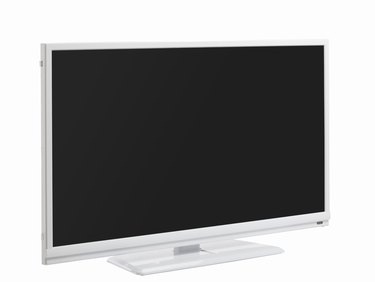
Depreciation is a measure of the value lost by an asset in each period of use. In the case of electronics such as an LCD TV, the process is fairly intuitive. Every TV owner knows that the device has a relatively short useful life, loses resale value every year and ultimately has to be scrapped. Exact depreciation calculations, however, can be very useful for tax purposes, in the event that you want to resell the device or just for your own record-keeping. These same calculations can be used for a variety of electronics, including plasma screens, 3D TVs and even computers.
Straight Line Depreciation
Video of the Day
Straight line depreciation is the easiest method for calculating depreciation and assumes that a device depreciates evenly over its useful life. The formula for this type of depreciation is simply the initial value of the asset minus its residual value divided by the number of years it is expected to be in use. As an example, assume a $2,700 LCD TV has a useful life of 5 years and can be recycled for $200 dollars at the end of those five years. The value to be depreciated is then $2,500 dollars (2,700 - 200) and the annual depreciation is $500 (2,500 / 5).
Video of the Day
Reducing Balance Depreciation
Reducing balance depreciation calculates depreciation by a constant rate while taking the reduced value of the asset into account. In the case of a $2,700 LCD TV with a $200 dollar scrap value, the depreciating amount is considered to be $2,500. Each year, the asset depreciates by a fixed percentage over 5 years. If, for example, you use 30 percent, the first year depreciation would be $750 (2,500 x .30). In the second year, the depreciation is calculated over the reduced value of $1,750, since the TV is now worth less. Second year depreciation would be $525 (1,750 x .30) and so forth for all five years. In the final year, the depreciation amount is whatever is left above the $200 scrap value.
Sum of Years Depreciation
Sum of years depreciation is used to calculate depreciation based on the number of useful years left in the asset's life. Like reducing balance depreciation, this method devalues an asset more quickly in the first years and is especially useful for electronics with a short useful life. The total depreciable amount is multiplied by a proportion of useful years divided by the sum of all the useful years. In the case of an LCD TV with a five-year useful life, that proportion in the first year would be 5/15 (5 useful years/5+4+3+2+1). First year depreciation assuming a $2,500 depreciating value would be $833 (2,500 x 5/15). Second year depreciation would be $667 (2,500 x 4/15). The calculation is performed each year until the full depreciable amount is exhausted on the fifth year.
A Note on Taxes
If you are calculating depreciation of your TV for tax purposes in the United States, you must comply with IRS guidelines for business deductions. The IRS uses straight line depreciation for electronics. In the case of an LCD TV that may also have recreational value outside of its business functions, the IRS asks you to determine the percentage of time the device is used for business. You may only write off that percentage of depreciation. If, for instance, you use the TV 75 percent of the time for business, you can only deduct 75 percent of the depreciation as a business expense. The IRS may ask you to prove that the TV is used for business purposes.